The Healthy Breakfast That Might Surprise You
Avocado toast has become a symbol of modern, health-conscious breakfasts appearing everywhere from trendy cafés to social media feeds. While it looks fresh and wholesome, its calorie content can be surprisingly high depending on the ingredients.
I first turned to avocado toast during my own wellness journey, searching for a breakfast that felt indulgent without sabotaging my goals. It seemed like the perfect choice—simple, satisfying, and packed with nutrients. But once I started tracking my meals, I was surprised to see how quickly the calories added up, especially once I factored in trendy toppings like poached eggs, feta cheese, or a drizzle of olive oil.
Still, that doesn’t mean avocado toast is off the table—far from it. This dish can be incredibly nourishing when made with intention. It’s rich in healthy fats, fiber, and essential vitamins, and it can be easily customized to suit a range of dietary needs. In this article, we’ll explore the true calorie count behind avocado toast and how to enjoy it in a balanced, delicious way.
Table of Contents
What You’ll Need: Ingredients & Smart Swaps for Every Diet
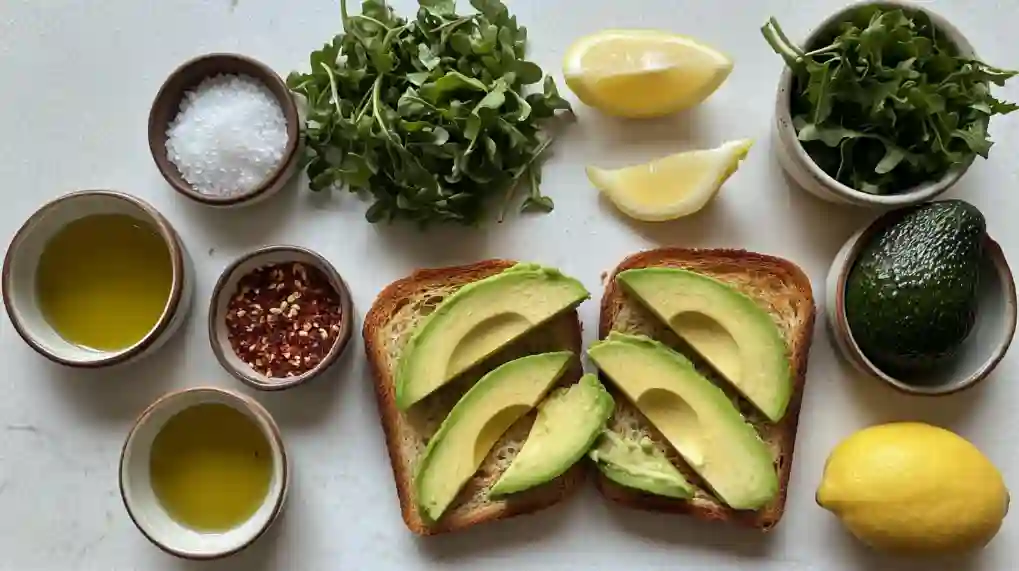
Avocado toast is celebrated for its simplicity, but the magic lies in the ingredients you choose. Whether you’re going for a basic version or a fully loaded gourmet slice, each component can make a difference in both flavor and calorie count. Below is a breakdown of the essentials and extras—plus a few smart swaps to suit your preferences or dietary needs.
Base Ingredients (Classic Avocado Toast)
- 1 slice whole grain bread (80–120 calories)
- ½ ripe avocado (120–140 calories)
- A pinch of sea salt and black pepper (negligible calories)
- ½ tsp lemon juice (1–2 calories)
This simple base comes in around 200–260 calories, depending on your bread and avocado size.
Popular Toppings & Add-Ons
- Poached egg (70–80 calories)
- Feta cheese (1 tbsp) (50–60 calories)
- Cherry tomatoes (a handful) (10–15 calories)
- Chili flakes (negligible calories)
- Olive oil (1 tsp drizzle) (40 calories)
- Pumpkin or sunflower seeds (1 tsp) (25–30 calories)
With toppings, your toast can easily range from 300–450+ calories, especially when layering proteins and fats.
Suggested Ingredient Swaps
- Vegan alternatives: Try hummus or mashed white beans in place of cheese or eggs.
- Low-carb/keto-friendly breads: Use almond flour bread or thin seed-based crackers.
- Dairy-free spreads: Replace feta with cashew cheese or nutritional yeast for a savory touch.
Tips for the Best Flavor & Texture
- Avocados: Choose ones that yield slightly to pressure without feeling mushy. Overripe avocados can be bitter or bland.
- Bread: Opt for thick-sliced sourdough or whole grain for the best crunch and structure. Toast until golden brown to hold up against the creamy topping.
Choosing the right base and balancing toppings helps you build an avocado toast that’s both delicious and calorie-conscious.
Step-by-Step Guide: How to Make the Perfect Avocado Toast
Avocado toast may seem like a simple dish, but getting that perfect balance of texture, flavor, and visual appeal requires a little know-how. Follow these step-by-step instructions to create an avocado toast that’s not only delicious but also looks like it came straight out of your favorite brunch café.
1. Choosing and Prepping Your Bread
Start with the foundation—your bread. Whole grain and sourdough are excellent choices for their flavor and nutritional value. Sourdough has a subtle tang and chewy texture, while whole grain offers a nutty richness and added fiber.
Tip: Choose a slice that’s thick enough to hold toppings without getting soggy. A ½ to ¾-inch slice works best.
Before toasting, you can lightly brush the bread with olive oil if you like an extra-crispy finish. For gluten-free or low-carb diets, swap in seed bread or thin-sliced almond flour bread.
2. Preparing the Avocado Spread
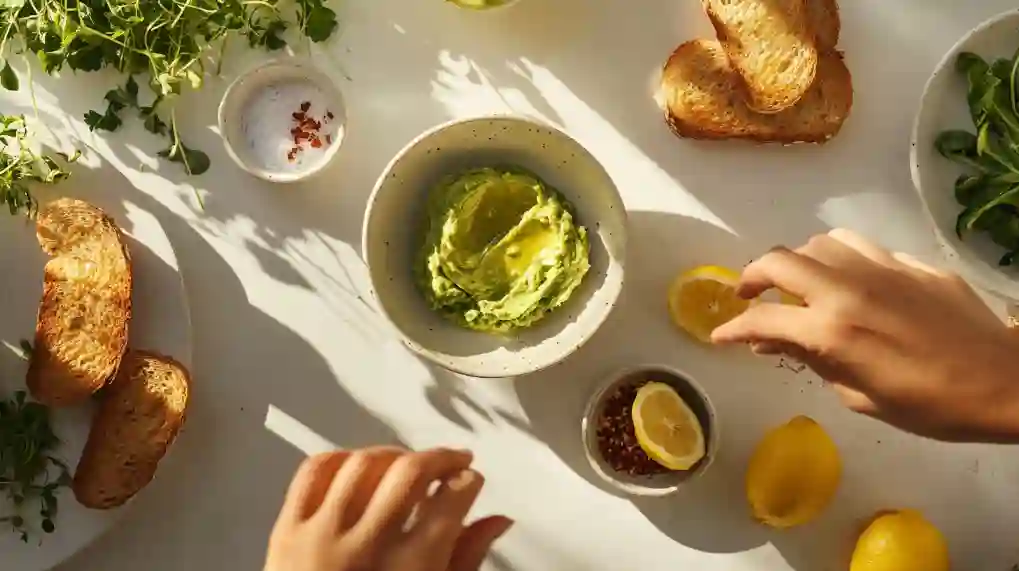
Slice your avocado in half lengthwise, remove the pit, and scoop the flesh into a bowl. Use a fork to mash it—go for a chunky or smooth consistency based on your preference.
Season well: Add a pinch of sea salt, freshly ground pepper, and a splash of lemon juice (½ to 1 tsp). The lemon not only enhances the flavor but also helps prevent browning.
Texture tip: If the avocado is too firm, let it sit at room temperature for a day or two in a paper bag. If it’s overripe, it may taste bitter—discard any brown or stringy parts.
3. Toasting and Assembling
Toast your bread until it’s golden and crisp, but not too hard. The ideal slice has a crunchy exterior with a tender middle—strong enough to carry toppings without crumbling.
Spread your mashed avocado generously over the toast. Don’t press too hard; keep the avocado light and fluffy to preserve its texture.
4. Adding Optional Toppings
This is where you can get creative—or stay classic. Some topping ideas to consider:
- Poached egg: Adds protein and richness. Poach in gently simmering water with a splash of vinegar for 3–4 minutes.
- Cherry tomatoes: Halved and lightly salted, they add brightness and color.
- Feta or goat cheese: A sprinkle brings tanginess and creaminess.
- Chili flakes or hot sauce: For heat lovers.
- Seeds: Sprinkle pumpkin, sesame, or sunflower seeds for crunch and nutrients.
- Drizzle of olive oil: Adds healthy fats and a glossy finish.
Pro tip: Assemble just before serving to keep the toast crisp and the avocado vibrant.
Extra Tips & Meal Prep Options
- Keep avocado green: Mix in lemon juice and store the mash in an airtight container with plastic wrap pressed against the surface. Use within 24 hours.
- Save time in the morning: Toast bread and prepare toppings in advance. Store avocado mash separately and assemble just before eating.
- Make it grab-and-go: Use whole grain wraps or tortillas instead of toast for a portable version.
With the right technique and a little creativity, your avocado toast can be as beautiful as it is nourishing—ready in under 10 minutes and endlessly customizable.
Tips & Flavor Variations to Keep Your Avocado Toast Exciting
One of the greatest things about avocado toast is how endlessly adaptable it is. Whether you’re following a specific diet, watching your calorie intake, or just craving something new, there’s a variation for everyone. Here are some tips and flavor twists to keep your avocado toast exciting—and tailored to your lifestyle.
Adapting for Different Diets
- Low-Calorie Version:
Use thin-sliced bread or a rice cake as your base, and limit toppings to the essentials. Stick to ¼ avocado per slice and load up on fresh veggies like cucumber, radish, or tomato to keep it light yet satisfying—keeping your toast under 250 calories. - High-Protein Boost:
Add a poached or boiled egg, sprinkle with hemp seeds or chia seeds, or spread a thin layer of cottage cheese beneath the avocado for extra protein. This is perfect for post-workout meals or fueling a busy morning. - Vegan-Friendly Combos:
Ditch the dairy and eggs in favor of plant-based toppings like marinated tofu, hummus, or roasted chickpeas. Nutritional yeast adds a cheesy flavor without any animal products.
Flavor Variations
- Mediterranean:
Top with crumbled feta, kalamata olives, cherry tomatoes, and a sprinkle of oregano or fresh mint for a refreshing and savory bite. - Spicy:
Add sriracha, chili oil, or red pepper flakes to the avocado mash, and top with sliced jalapeños for a bold, fiery twist. - Sweet-Savory:
Drizzle honey over the avocado and pair with fresh berries or pomegranate seeds. Add a pinch of sea salt to balance the sweetness.
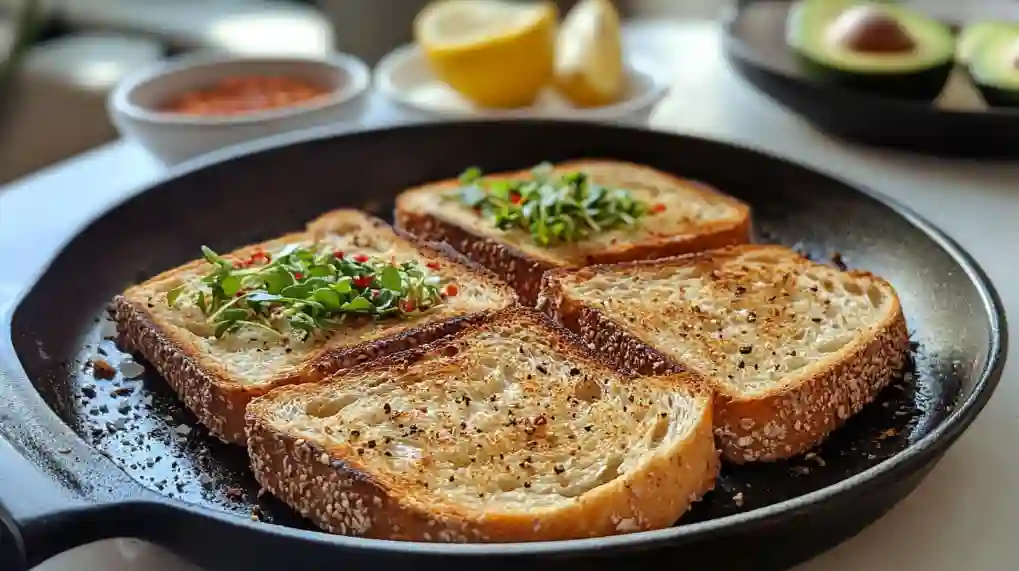
Creative Serving Ideas
- Open-face (classic) on thick toast
- Sandwich-style with grilled veggies or vegan deli slices
- Mini toast bites on crostini or sweet potato slices—great for parties or snacks
Best Pairings
Serve with a green smoothie, herbal tea, or a fresh-squeezed juice like orange-carrot-ginger for a vibrant, complete breakfast experience.
Nutritional Breakdown: Calories, Macros & Health Benefits
Avocado toast is more than just a trendy breakfast—it’s a nutrient-dense meal that can support energy, satiety, and overall wellness. However, depending on your ingredients, the calorie count can vary widely.
Calorie Range Per Slice
- Basic version (1 slice whole grain bread + ½ avocado): ~220–260 calories
- Loaded version (add egg, olive oil, cheese, or seeds): ~350–450+ calories
These numbers can shift based on portion sizes, bread type, and toppings, so it’s always worth measuring if you’re tracking macros.
Macronutrient Breakdown
- Calories: ~220–450 per serving
- Healthy Fats:
- From avocado and olive oil
- Roughly 15–25g per serving (mostly monounsaturated fats, great for heart health)
- Carbohydrates:
- ~15–30g depending on bread type (whole grain adds fiber and slows digestion)
- Protein:
- ~3–10g
- Boosted with toppings like eggs, seeds, or cheese
Micronutrient Highlights
- Fiber: Avocados and whole grain bread provide 6–10g per slice, promoting digestion and fullness.
- Potassium: A single avocado contains more potassium than a banana—key for muscle and nerve function.
- B Vitamins: Including B6 and folate, which support brain health and energy metabolism.
- Vitamin E & K: Found in avocados and olive oil, supporting skin, heart, and bone health.
Why It Keeps You Full
Thanks to its balance of healthy fats, complex carbs, and optional proteins, avocado toast digests slowly, preventing blood sugar spikes and energy crashes. It’s a great breakfast option that keeps you feeling satisfied well into the morning—perfect for busy days or post-workout recovery.
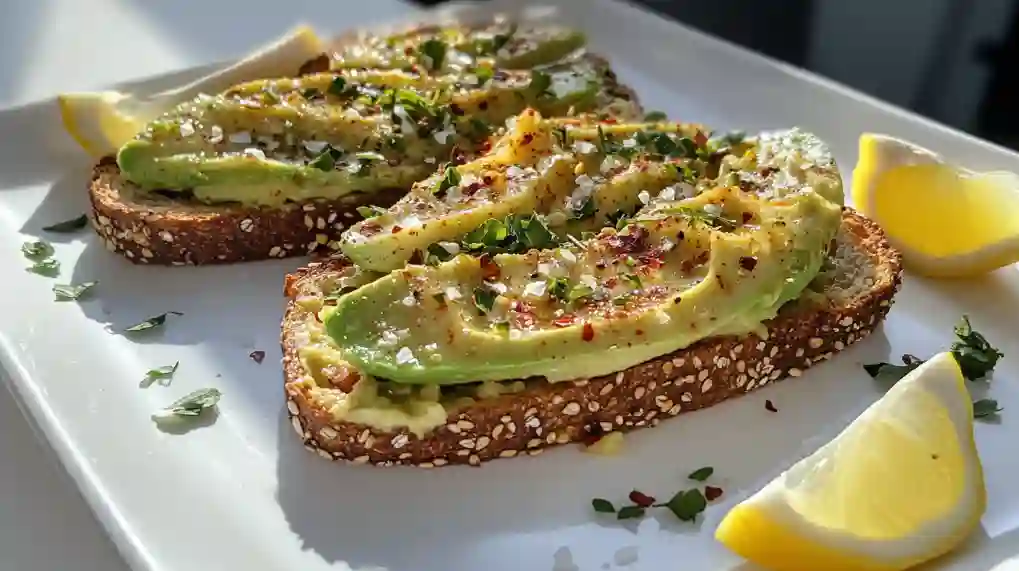
Common Mistakes (And How to Fix Them) for Better Avocado Toast
Even with a simple dish like avocado toast, small missteps can affect the taste, texture, and overall experience. Here are some of the most common mistakes people make—and how to fix them for the perfect slice every time.
Mistake: Using Underripe or Overripe Avocados
Fix: A good avocado should yield slightly when pressed but not feel mushy. If it’s too firm, place it in a paper bag with a banana or apple for a day or two to speed up ripening. If it’s overly soft, stringy, or brown inside, it’s likely overripe and should be discarded. Fresh, ripe avocados give you that creamy, buttery consistency essential for a perfect spread.
Mistake: Overloading Toppings, Making It Soggy
Fix: While it’s tempting to pile on all your favorite add-ons, too many moist ingredients (like tomatoes, soft cheese, or poached eggs) can overwhelm the toast. Layer ingredients strategically: keep avocado as the base, followed by drier toppings like seeds or greens, and add sauces or drizzles last—right before serving. Toasting the bread well also helps resist sogginess.
Mistake: Burning Toast or Uneven Texture
Fix: Use medium-high heat and monitor closely. Toast until golden and crisp but not hard or charred. If using a pan, press lightly with a spatula for even browning. In a toaster, go for medium settings and adjust based on your bread’s thickness and moisture.
Mistake: Lack of Flavor
Fix: Avocado alone can be bland. Season your mash with salt, black pepper, and fresh lemon or lime juice. Optional: add garlic powder, chili flakes, or a touch of cumin for depth. Acid and salt are non-negotiable—they bring out the best in your avocado.
Mistake: Poor Ingredient Pairing
Fix: Stick to flavor combos that complement each other. Classic pairings include avocado + egg + chili flakes, or avocado + tomato + feta + basil. Avoid mixing too many bold flavors that clash or overpower the avocado’s subtle richness. Simplicity often wins.
FAQs : Frequently Asked Questions About Avocado Toast
Here are some of the most frequently asked questions about avocado toast—answered with practical tips to help you make the most of this popular, nutritious meal.
Can I make avocado toast ahead of time?
While avocado toast is best enjoyed fresh, you can prep parts of it ahead of time. Toast your bread and store it in an airtight container or zip bag to keep it crisp. For the avocado mash, add extra lemon or lime juice to slow oxidation, then press plastic wrap directly onto the surface before refrigerating. Use within 24 hours for best taste and color. Assemble the toast just before eating to prevent sogginess.
What’s the best bread for low-calorie avocado toast?
Choose thin-sliced whole grain, sprouted grain, or light rye bread—each typically ranges from 40–70 calories per slice. Avoid thick artisanal loaves if you’re counting calories. You can also use rice cakes or thin sweet potato slices as low-calorie, gluten-free alternatives.
How can I boost the protein content?
Add a poached or hard-boiled egg, a sprinkle of hemp or chia seeds, or a spoonful of cottage cheese or Greek yogurt. Plant-based eaters can try tofu scramble, tempeh bacon, or protein-packed hummus.
Is avocado toast suitable for weight loss?
Yes—when portioned properly. Avocados are calorie-dense but also rich in fiber and healthy fats, which promote satiety. Stick to half an avocado per slice and use whole grain or low-calorie bread to keep your meal balanced and within your calorie goals.
Can I use frozen avocado?
Yes, frozen avocado is convenient and can work well for toast. Let it thaw completely and mash with lemon juice and seasoning. Keep in mind the texture may be slightly softer than fresh.
What are the best toppings for flavor without too many extra calories?
Try cherry tomatoes, arugula, red onion, chili flakes, fresh herbs, or a splash of hot sauce. These add flavor, texture, and visual appeal without significantly increasing the calorie count.
Final Thoughts: Build Your Own, Share Your Creations & Explore More Recipes
Avocado toast truly earns its reputation as a versatile, nutritious, and satisfying breakfast option. With its balance of healthy fats, fiber, and essential vitamins, it can easily be tailored to suit a variety of dietary needs and flavor preferences. Whether you’re keeping it light with a simple avocado mash or loading it up with protein-rich toppings like eggs and seeds, the beauty of this dish lies in its customizability.
That said, being mindful of ingredients and portion sizes is key—especially if you’re watching your calorie intake. A slice here or an extra drizzle there can quickly turn a light meal into a heavy one. By tracking your toppings and experimenting with swaps, you can create an avocado toast that fits your health goals without compromising on taste.
Now it’s your turn—try out one of the variations we’ve covered or create your own twist. Do you have a favorite topping combo that takes your avocado toast to the next level? Share it in the comments—I’d love to hear what you come up with!
And if you’re looking for more wholesome breakfast inspiration, be sure to check out my recipes for [overnight oats] and [smoothie bowls]—both perfect companions for your health-focused mornings.

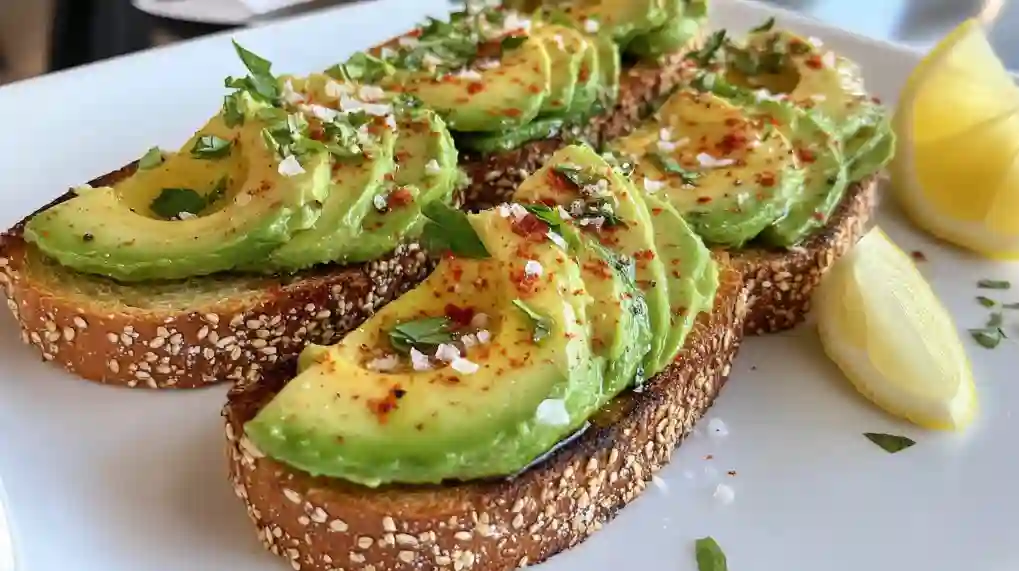
1 thought on “Avocado Toast Calories”
Comments are closed.